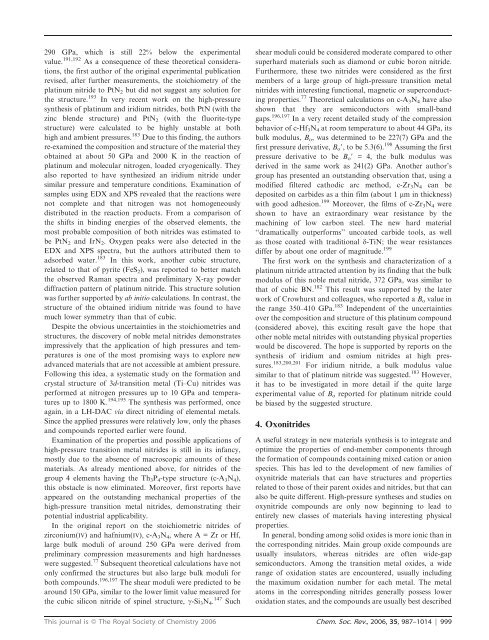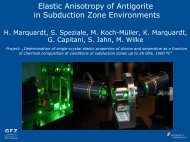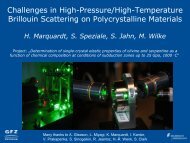High-pressure chemistry of nitride-based materials
High-pressure chemistry of nitride-based materials
High-pressure chemistry of nitride-based materials
Create successful ePaper yourself
Turn your PDF publications into a flip-book with our unique Google optimized e-Paper software.
290 GPa, which is still 22% below the experimental<br />
value. 191,192 As a consequence <strong>of</strong> these theoretical considerations,<br />
the first author <strong>of</strong> the original experimental publication<br />
revised, after further measurements, the stoichiometry <strong>of</strong> the<br />
platinum <strong>nitride</strong> to PtN 2 but did not suggest any solution for<br />
the structure. 193 In very recent work on the high-<strong>pressure</strong><br />
synthesis <strong>of</strong> platinum and iridium <strong>nitride</strong>s, both PtN (with the<br />
zinc blende structure) and PtN 2 (with the fluorite-type<br />
structure) were calculated to be highly unstable at both<br />
high and ambient <strong>pressure</strong>s. 183 Due to this finding, the authors<br />
re-examined the composition and structure <strong>of</strong> the material they<br />
obtained at about 50 GPa and 2000 K in the reaction <strong>of</strong><br />
platinum and molecular nitrogen, loaded cryogenically. They<br />
also reported to have synthesized an iridium <strong>nitride</strong> under<br />
similar <strong>pressure</strong> and temperature conditions. Examination <strong>of</strong><br />
samples using EDX and XPS revealed that the reactions were<br />
not complete and that nitrogen was not homogeneously<br />
distributed in the reaction products. From a comparison <strong>of</strong><br />
the shifts in binding energies <strong>of</strong> the observed elements, the<br />
most probable composition <strong>of</strong> both <strong>nitride</strong>s was estimated to<br />
be PtN 2 and IrN 2 . Oxygen peaks were also detected in the<br />
EDX and XPS spectra, but the authors attributed them to<br />
adsorbed water. 183 In this work, another cubic structure,<br />
related to that <strong>of</strong> pyrite (FeS 2 ), was reported to better match<br />
the observed Raman spectra and preliminary X-ray powder<br />
diffraction pattern <strong>of</strong> platinum <strong>nitride</strong>. This structure solution<br />
was further supported by ab initio calculations. In contrast, the<br />
structure <strong>of</strong> the obtained iridium <strong>nitride</strong> was found to have<br />
much lower symmetry than that <strong>of</strong> cubic.<br />
Despite the obvious uncertainties in the stoichiometries and<br />
structures, the discovery <strong>of</strong> noble metal <strong>nitride</strong>s demonstrates<br />
impressively that the application <strong>of</strong> high <strong>pressure</strong>s and temperatures<br />
is one <strong>of</strong> the most promising ways to explore new<br />
advanced <strong>materials</strong> that are not accessible at ambient <strong>pressure</strong>.<br />
Following this idea, a systematic study on the formation and<br />
crystal structure <strong>of</strong> 3d-transition metal (Ti–Cu) <strong>nitride</strong>s was<br />
performed at nitrogen <strong>pressure</strong>s up to 10 GPa and temperatures<br />
up to 1800 K. 194,195 The synthesis was performed, once<br />
again, in a LH-DAC via direct nitriding <strong>of</strong> elemental metals.<br />
Since the applied <strong>pressure</strong>s were relatively low, only the phases<br />
and compounds reported earlier were found.<br />
Examination <strong>of</strong> the properties and possible applications <strong>of</strong><br />
high-<strong>pressure</strong> transition metal <strong>nitride</strong>s is still in its infancy,<br />
mostly due to the absence <strong>of</strong> macroscopic amounts <strong>of</strong> these<br />
<strong>materials</strong>. As already mentioned above, for <strong>nitride</strong>s <strong>of</strong> the<br />
group 4 elements having the Th 3 P 4 -type structure (c-A 3 N 4 ),<br />
this obstacle is now eliminated. Moreover, first reports have<br />
appeared on the outstanding mechanical properties <strong>of</strong> the<br />
high-<strong>pressure</strong> transition metal <strong>nitride</strong>s, demonstrating their<br />
potential industrial applicability.<br />
In the original report on the stoichiometric <strong>nitride</strong>s <strong>of</strong><br />
zirconium(IV) and hafnium(IV), c-A 3 N 4 , where A = Zr or Hf,<br />
large bulk moduli <strong>of</strong> around 250 GPa were derived from<br />
preliminary compression measurements and high hardnesses<br />
were suggested. 77 Subsequent theoretical calculations have not<br />
only confirmed the structures but also large bulk moduli for<br />
both compounds. 196,197 The shear moduli were predicted to be<br />
around 150 GPa, similar to the lower limit value measured for<br />
the cubic silicon <strong>nitride</strong> <strong>of</strong> spinel structure, c-Si 3 N 4 . 147 Such<br />
shear moduli could be considered moderate compared to other<br />
superhard <strong>materials</strong> such as diamond or cubic boron <strong>nitride</strong>.<br />
Furthermore, these two <strong>nitride</strong>s were considered as the first<br />
members <strong>of</strong> a large group <strong>of</strong> high-<strong>pressure</strong> transition metal<br />
<strong>nitride</strong>s with interesting functional, magnetic or superconducting<br />
properties. 77 Theoretical calculations on c-A 3 N 4 have also<br />
shown that they are semiconductors with small-band<br />
gaps. 196,197 In a very recent detailed study <strong>of</strong> the compression<br />
behavior <strong>of</strong> c-Hf 3 N 4 at room temperature to about 44 GPa, its<br />
bulk modulus, B o , was determined to be 227(7) GPa and the<br />
first <strong>pressure</strong> derivative, B o 9, to be 5.3(6). 198 Assuming the first<br />
<strong>pressure</strong> derivative to be B o 9 = 4, the bulk modulus was<br />
derived in the same work as 241(2) GPa. Another author’s<br />
group has presented an outstanding observation that, using a<br />
modified filtered cathodic arc method, c-Zr 3 N 4 can be<br />
deposited on carbides as a thin film (about 1 mm in thickness)<br />
with good adhesion. 199 Moreover, the films <strong>of</strong> c-Zr 3 N 4 were<br />
shown to have an extraordinary wear resistance by the<br />
machining <strong>of</strong> low carbon steel. The new hard material<br />
‘‘dramatically outperforms’’ uncoated carbide tools, as well<br />
as those coated with traditional d-TiN; the wear resistances<br />
differ by about one order <strong>of</strong> magnitude. 199<br />
The first work on the synthesis and characterization <strong>of</strong> a<br />
platinum <strong>nitride</strong> attracted attention by its finding that the bulk<br />
modulus <strong>of</strong> this noble metal <strong>nitride</strong>, 372 GPa, was similar to<br />
that <strong>of</strong> cubic BN. 182 This result was supported by the later<br />
work <strong>of</strong> Crowhurst and colleagues, who reported a B o value in<br />
the range 350–410 GPa. 183 Independent <strong>of</strong> the uncertainties<br />
over the composition and structure <strong>of</strong> this platinum compound<br />
(considered above), this exciting result gave the hope that<br />
other noble metal <strong>nitride</strong>s with outstanding physical properties<br />
would be discovered. The hope is supported by reports on the<br />
synthesis <strong>of</strong> iridium and osmium <strong>nitride</strong>s at high <strong>pressure</strong>s.<br />
183,200,201 For iridium <strong>nitride</strong>, a bulk modulus value<br />
similar to that <strong>of</strong> platinum <strong>nitride</strong> was suggested. 183 However,<br />
it has to be investigated in more detail if the quite large<br />
experimental value <strong>of</strong> B o reported for platinum <strong>nitride</strong> could<br />
be biased by the suggested structure.<br />
4. Oxo<strong>nitride</strong>s<br />
A useful strategy in new <strong>materials</strong> synthesis is to integrate and<br />
optimize the properties <strong>of</strong> end-member components through<br />
the formation <strong>of</strong> compounds containing mixed cation or anion<br />
species. This has led to the development <strong>of</strong> new families <strong>of</strong><br />
oxy<strong>nitride</strong> <strong>materials</strong> that can have structures and properties<br />
related to those <strong>of</strong> their parent oxides and <strong>nitride</strong>s, but that can<br />
also be quite different. <strong>High</strong>-<strong>pressure</strong> syntheses and studies on<br />
oxy<strong>nitride</strong> compounds are only now beginning to lead to<br />
entirely new classes <strong>of</strong> <strong>materials</strong> having interesting physical<br />
properties.<br />
In general, bonding among solid oxides is more ionic than in<br />
the corresponding <strong>nitride</strong>s. Main group oxide compounds are<br />
usually insulators, whereas <strong>nitride</strong>s are <strong>of</strong>ten wide-gap<br />
semiconductors. Among the transition metal oxides, a wide<br />
range <strong>of</strong> oxidation states are encountered, usually including<br />
the maximum oxidation number for each metal. The metal<br />
atoms in the corresponding <strong>nitride</strong>s generally possess lower<br />
oxidation states, and the compounds are usually best described<br />
This journal is ß The Royal Society <strong>of</strong> Chemistry 2006 Chem. Soc. Rev., 2006, 35, 987–1014 | 999





